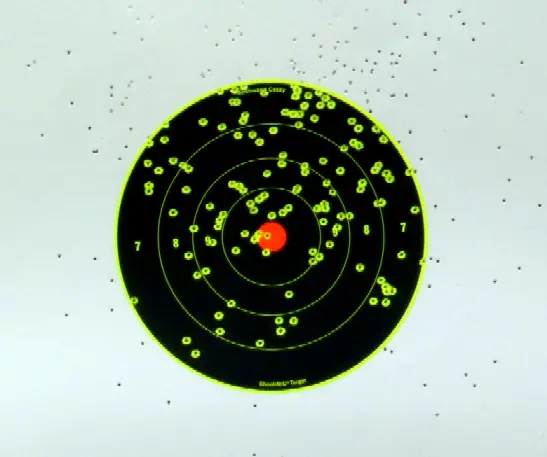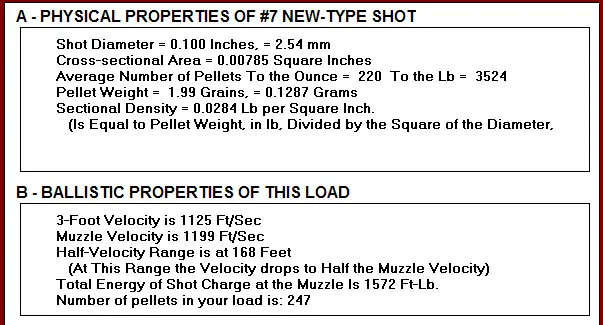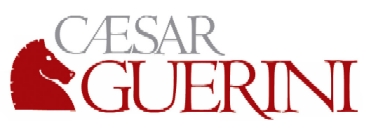


The Sixty Yard Twenty Gauge Wild Pheasant Load
Though marketed as
a reduced recoil turkey load, the absolute best twenty gauge wild pheasant
shotshell on the market is the Federal 2-3/4 inch 1-1/8 oz. Heavyweight
#7 shell. It has produced instant, dead in the air single shot drops,
repeatedly over years, at past 60 yards for me, as verified by laser rangefinder,
though that would certainly not be the typical range. The reason it is
such an effective load isn't hard to discern. Comparing 1-1/4 oz. #5 lead
(20 gauge, 3 in.) vs. 1-1/8 oz. Federal Heavyweight #7 (20 gauge 2-3/4
in.) at 50 yards:

The Federal Heavyweight #7 1-1/8 oz. load essentially does at 50 yards what our 1-1/4 oz. #5 lead load manages at 40 yards. HWT #7 vs. #5 lead at 50 yards is no contest: Heavyweight #7 yields less recoil, 15% more pellets, better energy density, and over 22% better penetration: it has better penetration at 60 yards (1.68 in.) than #5 lead has ... at 50 yards.
The above video clip is a very recent example, a nervous running pheasant flushing wild, during 22 degree F. ambient temperature, an 18 - 20 mph wind, gusting to 38 - 40 mph. It isn't the type of day to rely on a whimpy or poorly patterning, borderline penetration-level shell. The rooster actually fell at 54 yards, measured by Leupold RX-1000 laser rangefinder from where I was standing when I took the shot. That's one of the benefits of carrying a laser rangefinder with you: it takes guessing out of the equation.
This shell patterns tightly, so where it would often be a Full choke application with a lead shell, a Trulock Precision Hunter Modified creates more than adequate coverage to 60 yards and change. Some will misread this article, thinking it is only about a shot or a gauge. It isn't, for it is about a high density load and its capability, meaning "up to 60 yards," not at all suggesting (much less promoting) the notion that pheasants should be taken at 60 yards as much as possible. Although this specific shell in a 20 gauge is more effective than most 12 gauge loads, it hardly suggests that a 20 gauge is ballistically superior to a 12 gauge. This same high gravimetic density tungsten shot material, 15 g/cc, is also available in 12 gauge: a 1300 fps 1-1/4 oz. Heavyweight #7 load that offers even higher pellet count, about 275, Federal load #PHT154F.
For general purposes and for the sake of economy, the Remington 1-1/4 oz. three inch Nitro Turkey #5 buffered shells do a fabulous job, within the limits of lead's density as a pellet material. All the following wild roosters were taken this year with the Remington Nitro Turkey #5 lead shotshells.
The better buffered #5 lead loads, the Remington used above and the 1-5/16 oz. Federal covered here: http://www.randywakeman.com/Pheasants_Past_Fifty_%20Yards.htm have long been good for fifty yards or so. It is the higher pellet count of the Federal Heavyweight loads and the higher density shot that provide both denser patterns and better penetration, resulting in the additional 8 - 10 yards of additional effective range. And, the recoil is noticeably less as well, as is clear from 1-1/8 oz. @ 1100 fps compared to 1-1/4 oz. @ 1185 fps or other faster, heavier loads.

Federal Heavyweight has the highest density shot commonly available at 15 grams per cubic centimeter. While its heavier payload bigger brother has been a devastating turkey load (above), that extreme level pattern density is naturally not wanted, much less required, for wingshooting. Many would view Heavyweight #7 as "turkey only," and in the case of the 1-1/2 oz. 20 gauge version, I agree. However, the 1-1/8 oz. 2-3/4 inch HWT #7 shell has an obvious field advantage over lead, and wild pheasant hunting is not at all not high volume shooting. The 247 pellet count of 1-1/8 oz. of Heavyweight #7 is what makes it better than its closest lead ballistic equivalent, #4, for even 1-3/4 oz. of lead #4 has less pellets at about 234.

This shell is a 60 yard capable 20 gauge pheasant shotshell, based on the fundametals of pattern density combined with sufficient penetration. Your pattern board will prove it to you.
As tested and used, it produces approximately 85% 40 yard patterns, meaning an average of 12.68 hits to a 20 inch square target. At 50 yards, about 57% for an average of 5.67 hits, and at 60 yards, the pattern percentage is just over 35%, for about 3 (2.96) hits on a 20 inch square target. The kill zone of a pheasant is somewhat larger, and not a square or a perfect circle. A 5 inch circle has an area of 19.63 inches, so the approximate vital zone hits discussed are slightly conservative.
Postscript

If you refer to the graphic above and below, you might be surprised to see that Heavyweight #7 has more penetration at 55 yards than #6 lead can manage at just 35 yards.

Above: A head to head comparison of the two pheasant loads I've been using, Heavyweight #7 vs. High Antimony Lead #5 @ yards.
Although the lead load is heavier at 1-1/4 oz., and has a slightly faster muzzle velocity meaning higher recoil, at 55 yards the Time of Flight to Target is identical at 0.215 second. Yet, the lower recoil Heavyweight #7 has a significantly better pellet count and significantly deeper penetration at 55 yards. The better pellet count and penetration is of benefit at all hunting ranges. The Heavyweight #7 load has about 14% more pellets (that do not deform on setback), 26% deeper penetration at 55 yards, and noticeably less recoil. For a six pound gun, the lead load has about 33.63 ft. lbs. of recoil energy vs. about 24.92 ft. lbs. of recoil energy for the Heavyweight load: the lead load has about 35% more actual recoil.
It is all made possible due to density. High antimony lead is about 11 g/cc, where Federal Heavyweight is 15 g/cc: over 36% more density. While it isn't D-38 depleted uranium (19.1 g/cc) it is right at halfway there, from lead.
Many readers are interested in the “best” shotshell / choke combinations, regardless of price, for wild pheasants. It isn't hard to figure out why, for if you have a passion for wild pheasant hunting and are not living in pheasant country, you may well take in a South Dakota weekend hunt that may run $700 for three days, not including guiding, bird dogs, meals, a South Dakota hunting license, or getting there in the first place.
A fully guided three day wild pheasant hunt may run $1500 or so, and that is for a total of nine birds over three days. It doesn't take a lot of fun math exercises to quickly discover that the cost of premium ammunition is trivia. When you have $2000 or more wrapped up in a premier wild pheasant hunt, the idea of scrimping on shotshells or choke tubes quickly becomes nonsensical. There is little in the way of logic that supports not using the very best shells you can find, the best choke tube, and the shotgun that you personally do the best with. It is for those folks, with a great level of enthusiasm for wild pheasant hunting, that high-density shotshell loads like the 15 g / cc Federal Heavyweight loads covered here are quite worthy of consideration. If you want the Magic, as the saying goes, "Magic Always Comes With a Price."
Copyright 2014 by Randy Wakeman. All Rights Reserved.




